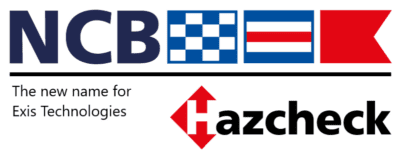Change is a challenge – Hazardous Cargo Bulletin
Exis Technologies has its roots in the HCB of the 1980s. It has grown through a period of innovation and a massive change in scale.
Rewind to 1987 and please stay with this! You need to ship 400 litres of Grignard solution from Hamburg to Singapore. You know it’s hazardous so you try the IMDG Code general index. Page 10122 tells you it is UN 1928, class 4.3, packing group I and a flammable liquid. The schedule page is 4355-1. If it hadn’t been listed by name you would have looked in the UN Orange Book to see if it met any of the hazard class definitions, what the packing group was, and picked the appropriate generic or N.O.S. UN Number.
The schedule page tells you it is UN 1928, METHYLMAGNESIUM BROMIDE, IN ETHYL ETHER. The chemical formula is CH3MgBr, which is useful only to a chemist wanting to confirm the identity of it. It will be a colourless, yellowish liquid which decomposes violently in contact with water. Spillage will ignite spontaneously so helpfully it says to refuse shipment in damaged or leaking receptacles. The packaging choices are listed on the schedule page itself rather than to a table used by many class 4.3 substances. You pick 1 L glass receptacles each sealed in a metal can and then packed together in a 4D plywood box. They are limited to 125 kg gross so you will need several of them. The DG declaration is completed and everything has been collected by the forwarding agent. This is LCL (less than container load) so the consolidator uses his IMDG Code to check compatibility with other items in the container which is then booked with the carrier, whose DG department now checks the shipment against the IMDG Code, their own rules, segregation onboard and ship restrictions.
The process is much the same as today but in 1987 it involved the use of books, telephone, telex and fax, the latest technology. The ship is 2,000 teu and the whole movement takes a typical six weeks with too many hours of administration that is prone to error.
Leverage technology
This is the start point for Exis; an environment of long-established manual procedures and increasing DG incidents driving international implementation of the IMDG Code (for example the fire that destroyed the dry cargo ship Poona in Gothenburg in 1971, involving sodium chlorate and rapeseed oil). Information technology is developing and the arrival of commercial internet (or world wide web) is imminent. Some lines, notably Hapag Lloyd, have implemented in-house computerised DG systems, mostly replicating but speeding up their manual procedures. There is no industry-wide computer system or standards.
The first Exis products of the late 1980’s and early 1990’s were basic lookup tools for the international multimodal regulations, speeding up the booking process. They ran on customers’ servers and the early PCs, plus a clunky dial-up service. During the 1990s Exis focused on sea transport, building on its “Computerised IMDG Code”. Operators needed fast ‘yes/no’ answers to DG questions without laborious reference searches. This was the platform on which the Hazcheck family was built, tools for each link in the transport chain that simplified classification, packaging, segregation, stowage and documentation.
While functionality and IT were developing rapidly, there was reluctance to change tried and tested manual procedures, however cumbersome, slowing uptake of computerised alternatives. The DG process was rarely understood by senior management unwilling to go against vested interests. For each ‘go live’ day for a shipping line’s new DG booking system, the Exis team was on standby to field protests from consignors of rejected shipments that had been regularly but wrongly accepted up to that point. The lines needed to support their own customers in improving DG compliance. The relentless growth in traffic and vessel size, the increasing speed and sophistication of supply chains and the demands of manufacturing forced the pace. By the early 2000’s Exis Hazcheck systems were being implemented by most of the major container lines, a share that has climbed to 80% today.
Collaborate for safety
Another driving force was the need for the carriers to co-operate on misdeclared DG and harmonise systems. Up to this point, most carriers operated their own protocols making slot-sharing cumbersome and error-prone. In 2011 the Cargo Incident Notification System (CINS) was launched, a major industry collaboration to reduce DG incidents at sea. That mission has also led to the recent launch of Hazcheck Detect, an Exis cargo screening system to help detect misdeclared DG. Compared with a typical carrier’s daily transactions in the 1990’s of a few hundred shipment checks, Hazcheck Detect is currently processing a typical 6,200 shipments per hour, computer-to-computer with no human intervention 24/7/365.
Exis is now collaborating with major lines and organisations in developing similar collaborative solutions, notably with New York based container inspection company National Cargo Bureau (NCB) on development of Hazcheck Inspections, a web database and portal for planning, recording and analyzing container inspections and the development of common inspection standards.
In April 2018 NCB acquired Exis Technologies, bringing together the leading supplier of systems for the safe management of dangerous goods with NCB’s high reputation and authority in the regulatory and loss prevention environment. And setting the stage for further exciting development of DG solutions driven by the Group’s not-for-profit mission of safety of life and cargo at sea.
Ian Lennard, President of NCB, comments, “Exis has established itself over the last 40 years and now supplies Hazcheck validation (for declared DG cargo) to 9 of the top 10 container lines. The next chapter of the company has begun with the launch of Hazcheck Detect which will help prevent undeclared or mis declared DG being accepted and/ or loaded on to vessels. This service complements NCB cargo inspections, undeclared, misdeclared and poorly stowed dangerous goods cargoes represent a serious risk to life, property and the environment.”







